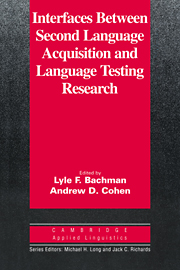Book contents
- Frontmatter
- Contents
- List of contributors
- Series editors' preface
- Preface
- Chapter 1 Language testing – SLA interfaces: An update
- Chapter 2 Construct definition and validity inquiry in SLA research
- Chapter 3 Research on interlanguage variation: Implications for language testing
- Chapter 4 Strategies and processes in test taking and SLA
- Chapter 5 Describing language development? Rating scales and SLA
- Chapter 6 Testing methods in context-based second language research
- Chapter 7 How can language testing and SLA benefit from each other? The case of discourse
- Appendix: Language testing – SLA research interfaces
- Index
Chapter 5 - Describing language development? Rating scales and SLA
Published online by Cambridge University Press: 05 October 2012
- Frontmatter
- Contents
- List of contributors
- Series editors' preface
- Preface
- Chapter 1 Language testing – SLA interfaces: An update
- Chapter 2 Construct definition and validity inquiry in SLA research
- Chapter 3 Research on interlanguage variation: Implications for language testing
- Chapter 4 Strategies and processes in test taking and SLA
- Chapter 5 Describing language development? Rating scales and SLA
- Chapter 6 Testing methods in context-based second language research
- Chapter 7 How can language testing and SLA benefit from each other? The case of discourse
- Appendix: Language testing – SLA research interfaces
- Index
Summary
Over the last decade or so, rating scales describing different levels of language proficiency or achievement have been widely adopted in language learning programs throughout the world as a means of assessing individual learner attainment and reporting program outcomes. Such scales have tended to be of two main types. The first type of scale is behaviourally based and is exemplified by instruments such as the American Council on the Teaching of Foreign Languages Proficiency Guidelines (ACTFL 1986), which seek to define language ability globally in terms of features of “real-life” performance and thus describe specific contexts of language use. Although behavioural scales have generally met with widespread acceptance within the language teaching fraternity, their theoretical foundations have been questioned (e.g., Bachman & Savignon 1986; Lantolf & Frawley 1988). Their validity as indicators of language ability has also been challenged on the basis that the scales fail to distinguish between the ability being assessed and the elicitation procedures used, thus limiting the generalizability of score interpretation (Bachman 1990). Their usefulness for diagnostic and achievement testing has also been questioned, in that they fail to provide specific information on different components of language ability (Bachman 8c Palmer 1996). As a result, proposals have been put forward for a second type of rating scale, one that is defined independently of content and context, that is derived from a theoretical model of the ability construct being assessed, and that provides analytic ratings of the various components of language ability that may be of interest to stake holders (Bachman 1988,1990; Bachman & Palmer, 1996).
- Type
- Chapter
- Information
- Publisher: Cambridge University PressPrint publication year: 1999
- 4
- Cited by



